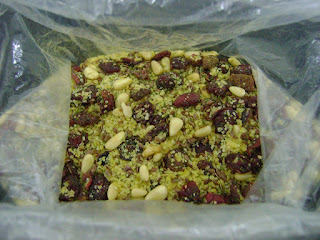By now we've all heard that whole grains are healthier. However, one of the greatest barriers to eating whole grains is that they take longer to cook. Both singles and families are often pressed for time and turn to instant foods. I want to encourage you to engineer healthy snacks and meals you can prepare ahead of time that work for your tastes and lifestyle. Here's an idea:
 1. Find an airtight container, like the kind you might use to store flour or cereal. (You can also use a zip-top bag.) Fill it half way with Bulgur Wheat, which you can find in spice stores, health food stores, and the bulk bins of many grocers. You may find it in a box marketed as tabouli/tabbouleh, often with spices added. (Pictured above is a side-by-side comparison of dry and prepared bulgur.)
1. Find an airtight container, like the kind you might use to store flour or cereal. (You can also use a zip-top bag.) Fill it half way with Bulgur Wheat, which you can find in spice stores, health food stores, and the bulk bins of many grocers. You may find it in a box marketed as tabouli/tabbouleh, often with spices added. (Pictured above is a side-by-side comparison of dry and prepared bulgur.)2. Mix in your favorite dried herbs and spices. Consider,
- broken up, dry shitaki mushrooms
- garlic powder or dehydrated garlic flakes
- dried onions
- salt & pepper
- pistachios, slivered almonds, shopped cashews, pine nuts, other nuts
- shelled sunflower seeds, sesame seeds, flax seeds, other seeds
- raisins, currants, or dried cranberries
- dill, dry mint, cumin, coriander
- za'atar, curry powder, herbes de Provence, Italian seasoning, or your favorite spice mix.
3. Shake and store until your are hungry for an easy snack or need a side dish lickity-split. It will keep at room temperature for at least a couple weeks, but I prefer to store my mix in the fridge or freezer to protect from bugs and preserve the healthful oils in the nuts and seeds.
4. Prepare by adding about twice as much boiling water as bulgur. Then cover and wait. If your grains are not soft and plump, add more boiling water and wait. I boil water in my electric kettle and add it to the grains in a glass or ceramic bowl. You can use the microwave, stove-top, or whichever method you prefer.
Bulgur wheat is already boiled, dried and cracked, so it cooks/rehydrates quickly. It is faster to prepare than Ramen noodles and higher in fiber, protein and vitamins than white rice. With a glycemic index in the low range, this is an excellent grain to keep on hand.
Additionally, you could add fresh herbs and vegetables like you would with tabbouleh. Try any or all of the items suggested in Quinoa Tabbouleh. Below is the nutrition information from Wikepedia.
1 cup of dry bulgur contains approximately:
- Energy: 2003 kJ (479 kcal)
- Dietary fiber: 25.6 g
- Protein: 17.21 g
- Carbohydrate: 69 g whereof 0.8 g sugars
- Fat: 1.86 g whereof 0.2 g saturated fat
- Potassium: 574 mg
- Iron: 3.44 mg
- Glycemic Index: 46 (I also saw 48 from other sources.)
If you are guilty of bringing instant noodles or soup to work for lunch, put your bulgur mix in a Tupperware container or in sandwich bags with a large Styrofoam cup in 1/2 cup portions. Add one cup hot water from the water cooler or coffee maker. You body will thank you. If you know a college student who needs to improve their eating habits, send them this wholesome alternative to Cup-O-Noodles.
Misspellings/alternatives include bulger, bulgar, tabouli, tabuli, taboula, tabouleh.




What a brilliant take-along lunch for work! SO much healthier (and tastier) than anything 'instant' you'll find at the supermarket. Great idea!
ReplyDeleteThanks for participating in my blog carnival
ReplyDeletehttp://www.naturallyradiant.info/site/school-lunch-blog-carnival/
It's going live tomorrow, and I included this recipe - it looks like a fantastic replacement for the instant noodles that my daughter's been asking for.